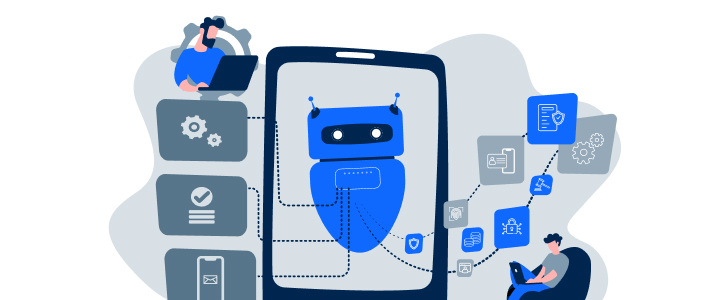At the dawn of an IT revolution: From instruction-based to intention-based computing
NVIDIA has played a key role in shaping the development of accelerated computing and AI. Marc Stampfli, Business Director Switzerland, talks to us about the “iPhone moment” of AI and how NVIDIA wants to democratize AI with a combination of hardware, a comprehensive software stack and concepts such as NVIDIA Inferencing Microservices (NIM).
NVIDIA is one of the world’s most valuable companies. Which products and services are part of your portfolio?
NVIDIA’s core competence lies in accelerated computing. We develop specialized computing platforms to drastically accelerate computationally intensive tasks and make them more efficient. Data centers around the world are switching to accelerated computing, as most modern applications are created in this environment. We are at the beginning of an IT revolution, the likes of which we have not seen in the last 60 years: the transition from instruction-based to intention-based computing.
To drive this transformation, we have spent the last 25 years developing our own computing platform with graphics processing units (GPUs), an ARM-based central processing unit (CPU) and a data processing unit (DPU/network accelerator). We have developed our DGX systems and DGX SuperPOD clusters – supercomputers for high-performance computing and artificial intelligence – on this technological basis. Together with device manufacturers and hyperscalers, we offer vendor-specific solutions to ensure maximum flexibility for our customers.
But hardware alone is not enough. In order to operate artificial intelligence efficiently and cost-effectively, a comprehensive software solution is required. That is why we have developed the NVIDIA AI enterprise software stack, which includes everything required for the development and high-performance operation of AI. The stack is independent of the deployment – so it doesn’t matter whether the solution is operated on-prem, in the cloud or in a hybrid infrastructure – and supports all the relevant major open-source language models, for which we also offer licensing support. Today, NVIDIA technology is integrated into almost every application that uses artificial intelligence.
“NVIDIA technology is integrated into almost every application that uses artificial intelligence.”– Marc Stampfli
You have benefited enormously from the development of artificial intelligence in recent months. What was this phase like for you?
The rapid development of AI in recent months came as no surprise to us – but rather, to our customers. Years ago, we were already talking about generative AI and language models as the next big topic, although many companies did not yet have it on their radar. This was because we had already been supporting the development of generative AI in research for several years. With more than 25 years of experience in accelerated computing, during this time we developed the concept of an “AI factory”. The efficient operation of AI requires not just a single chip, but a holistic full-stack approach. This includes GPUs, CPUs, network processors and the corresponding software. All these components must be integrated into a server that is optimized for AI. This also includes industry-specific software – for example, for the pharmaceutical or financial industry – which facilitates the development of end applications.
In 2016, we sold our first AI supercomputer, the DGX-1, to a then still unknown start-up and supported it in using large language models. It took another six years before OpenAI went public with ChatGPT and this technology could suddenly be used worldwide. That was AI’s “iPhone moment.”
However, we are currently observing a clear trend towards open-source and community models. Our customers have realized that they can operate large language models easily and efficiently in a controlled manner in their private cloud or their own data center and are not solely dependent on external services. This enables them to integrate confidential data into language models, improve models, use different models and provide access to company-internal or even confidential information.
What strategic topics and projects are you currently focusing on?
Our current strategic focus is on democratizing artificial intelligence and making it accessible to everyone. Until now, open-source models for generative AI required an in-depth understanding of the models and the software stack, which represented a significant hurdle for many companies. To meet these challenges, we have developed our NVIDIA Inferencing Microservices (NIM). These are AI models that are provided in containers, optimized for the hardware platform used, and equipped with all the necessary software to operate the model efficiently.
These microservices are accessed via an API, which makes it possible to develop applications independently of the underlying language model. In addition, language models can be easily updated as soon as new and improved versions are available. If we consider 2022 to be the “iPhone moment” of AI, then NIM represents the “iPhone app” in this context, so to speak.
However, our development work goes even further. We are already working on AI agents and blueprints that essentially combine workflows with various AI models and queries to internal systems. In principle, we are creating a digital employee for simple applications that automates processes and increases efficiency.
“Our focus is on the democratization of AI: with our NVIDIA Inferencing Microservices (NIM), we provide AI models in containers that are optimized for the hardware platform used, and equipped with all the necessary software. This reduces complexity and makes AI accessible to everyone.”– Marc Stampfli
Finally, a quick word about us: ti&m is celebrating its 20th anniversary this year ...
First of all, I would like to congratulate ti&m on its impressive success over the past 20 years. It is remarkable how much the company has grown. I wish you continued success in the future. I look forward to supporting you in your transformation into the age of artificial intelligence and continuing our successful collaboration.





